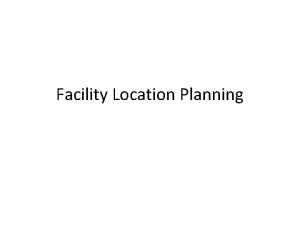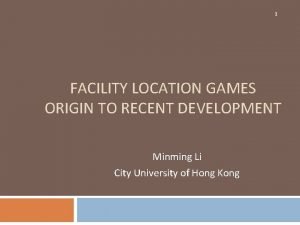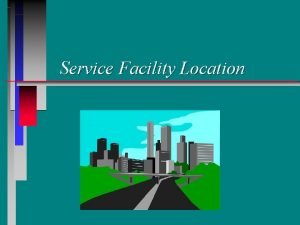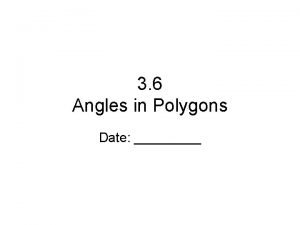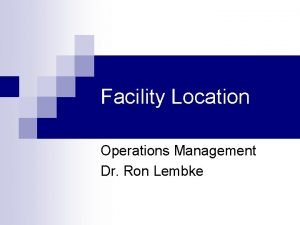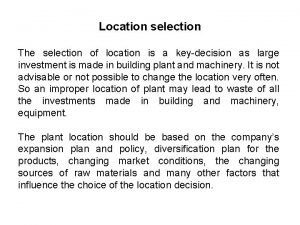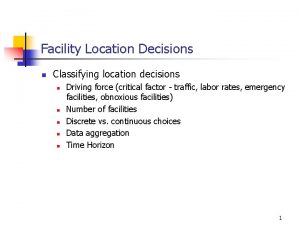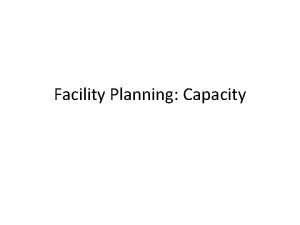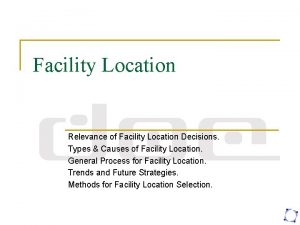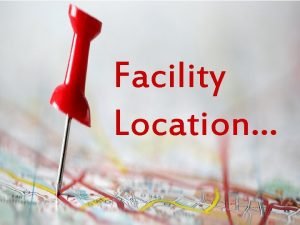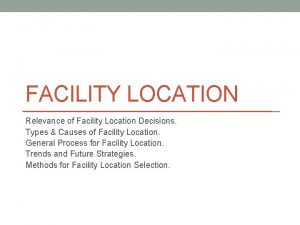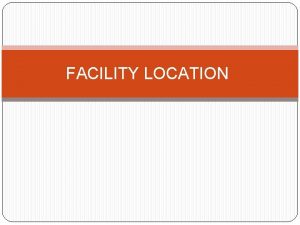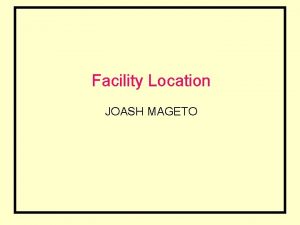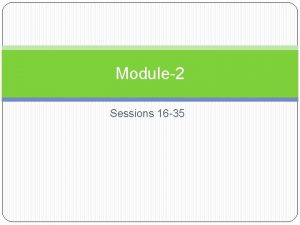Facility Location Planning Location Planning Interrelated facility planning









- Slides: 9

Facility Location Planning

Location Planning • Interrelated facility planning decisions: 1. 2. Location of facilities: geographic placement Number of facilities: facility types (manufacturing plants, distribution centers, retail outlets, etc. ) which make up distribution network Size of facilities (capacity): refers to the overall cubic feet and throughput (volume) rate which constrains all future facility operations. 3. This must also consider the layout. 4. Allocation of customers to facilities: order processing and fulfillment • • Important factors affecting the decision include: proximity, facility volume, transportation costs, customer importance, etc. Facility location dependent upon objective(s)

Strategic Importance 1. Capital investment (machinery, technology, land, buildings, etc. ) 2. Long-term commitment 3. Impact on costs (operating efficiency) 4. Numerous criteria

Location Planning Process 1. Each problem is unique 2. Scope of problem: Two levels • Level 1: Macro (national and regional), identifies a general location based upon primary cost, customer service standards, technological constraints, and dominant location factors; many possible locations eliminated at this level • (2) Level 2: Micro (local and specific), identifies an exact site within the general location; incorporates considerations which are not easily quantifiable 3. “Satisficing” solutions

Facility Location Methods of Analysis 1. Simple cost formulation combined with a complex optimization procedure 2. Complex cost model combined with a simple heuristic method to minimize the cost function

Single-Site Facility Location Problems 1. Hoover’s Strategies: e. g. , market-oriented, production-oriented 2. Cost-Volume-Profit (Breakeven) Analysis 3. Transportation Method of Linear Programming 4. Center of Gravity Approach 5. Others? E. g. , Payback, NPV, IRR, etc.

Multiple-Site Facility Locations • More complex decision-making problem due to its interdependence; large number of potential logistic system configurations; yet more realistic and more common as even many small firms have more than one facility. • Some methods of analysis: optimization (e. g. , LP), simulation methods, heuristic methods

Linear Scoring Rule (rating scale or weighted checklist) • Integrates both quantitative and qualitative factors • LSR Concerns 1. weights are subjective and solution sensitive 2. scores are subjective and solution sensitive 3. all factors considered? • Example A paint manufacturer would like to locate a retail store. A list of important location factors is presented below. Factor weights are assigned a number from 1 to 10 according to their relative importance of each factor (10 being most important). Each location factor is scored on a scale from 1 to 10 (10 representing the most favorable status).

LSR Example Factor Weighted Weight Location Factors Score 8 Proximity to competition 5 40 5 Rent/lease considerations 3 15 8 Parking Space 10 80 7 Proximity to complementary stores 8 56 6 Modernity of store space 9 54 Total Score: 245
 Facility location planning
Facility location planning Location planning and analysis in operation management
Location planning and analysis in operation management Facility location game
Facility location game Service facility location
Service facility location Sum of exterior angles of a hexagon
Sum of exterior angles of a hexagon Center of gravity method facility location example
Center of gravity method facility location example Selection of location
Selection of location Single facility location problem
Single facility location problem Objectives of
Objectives of Perencanaan lokasi pabrik dan tata letak fasilitas
Perencanaan lokasi pabrik dan tata letak fasilitas
